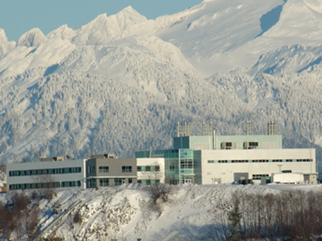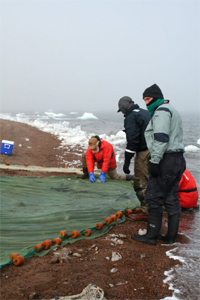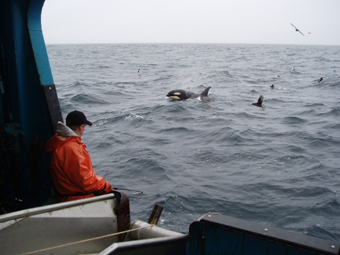

Auke Bay Laboratories
 |
|
Ted Stevens Marine Research Institute (Photo by John Hudson).
|
The Alaska Fisheries Science Center's Auke Bay Laboratories (ABL) conducts scientific research throughout Alaska on fish stocks, fish habitats, and the chemistry of marine environments. Information from this research is widely used by commercial interests such as fishing industries, and governmental agencies involved in managing natural resources (click here for a list of data sets). The headquarters of ABL is the Ted Stevens Marine Research Institute (pictured to the right), an office and laboratory building located at Lena Point, north of Juneau, Alaska (driving instructions). The ABL headquarters serves as the focal point for four other ABL facilities. Three ABL facilities are located in the City and Borough of Juneau at Auke Bay, Auke Creek, and downtown Juneau, and one is located at Little Port Walter, on Baranov Island, southeast of Sitka. Auke Bay Marine Station includes fresh and salt water laboratories, offices, and dive and docking facilities. Auke Creek Research Station is a permanent fish weir and hatchery owned by NOAA that is jointly operated with the University of Alaska Fairbanks School of Fisheries and Ocean Sciences and the Alaska Department of Fish and Game. The Juneau Subport Dock and Warehouse has berthing and crane facilities for ocean going vessels, warm dry storage, office space and the Alaska Department of Fish and Game boat repair and storage facility. Little Port Walter Marine Station has fixed and floating docks, office space, dry storage, bunkhouse and kitchen, and fish weir and hatchery.
 |
|
Habitat and Marine Chemistry.
Beaufort Sea sampling of coastal fish populations near Barrow, Alaska, August 2006. |
Marine survey data from ABL research on commercially marketable
species such as rockfish, sablefish, and salmon, and on non-marketable and/or
protected species such as eel grass, plankton, Steller sea lions, and harbor seals are
packaged in information products essential to fishing industries, state and
federal regulators, and international treaty bodies. Groups involved in managing
human activities in coastal environments frequently base their actions on ABL's
knowledge of the quantities and qualities of fish habitats in the affected
areas. ABL's capabilities in environmental chemistry research contribute
to greater understanding of the fate and effects of pollutants in marine ecosystems
and the structure and functioning of marine food webs. ABL is organized into
the four major research programs: Marine
Salmon Interactions, Marine Ecology and
Stock Assessment, Ocean
Carrying Capacity, and
Habitat Assessment and Marine Chemistry (Organizational Chart).
 |
|
Marine Ecology and Stock Assessment.
ABL sablefish longline survey on Alaskan Leader, 2004. |
For more information on ABL please contact (907) 789-6000. The ABL Director, Phil Mundy, can be reached at Phil.Mundy@noaa.gov or (907) 789-6001, and the ABL Deputy Director, Steve Ignell, at Steve.Ignell@noaa.gov or (907) 789-6029. For e-mail and telephone contact information on other ABL employees, please visit our personnel page.
News and Research Highlights
 |
|
New! NPAFC Newsletter
See page 5 of the latest North Pacific Anadromous Fish Commission (NPAFC) newsletter. Several ABL staff play a critical role in the BASIS research plan. More> |
| |
 |
|
New! ABL Data Sets Online
The following page contains data sets collected by Auke Bay Laboratories over the years. Along with the data set name, each entry contains the current principal investigator and their contact information, an abstract, and a copy of the metadata associated with that data set (in xml format). More> |
| |
 |
|
11th Annual Salmon Ocean Ecology Meeting
The 11th Annual Salmon Ocean Ecology Meeting is scheduled to be held in Juneau, Alaska on 7-8 April 2009. The purpose of this meeting is to foster communication and collaboration among researchers working on the ecology of Pacific salmon off the coasts of California, Oregon, Washington, British Columbia, and Alaska. More> |
| |
Featured Research, Publications, Posters, Reports, and Activities
- "Evidence of hook competition in longline surveys" by Cara Rodgveller, Chris Lunsford, and Jeff Fujioka
- "Density-dependent growth of Alaska sockeye salmon in relation to climate–oceanic regimes, population abundance, and body size, 1925 to 1998" by Ellen Martinson, Jack Helle, Dennis Scarnecchia, and Houston Stokes
- "Morphology and molecular phylogeny of Aureophycus aleuticus gen. et sp. nov (Laminariales, Phaeophyceae) from the Aleutian Islands" by Hiroshi Kawai, Takeaki Hanyuda, Mandy Lindeberg, and Sandra C. Lindstrom
- Forecasting Pink Salmon Harvest in Southeast Alaska
- Auke Bay Laboratories Research Reports and Activities
- Spatial distribution, energetic status, and food habits of eastern Bering Sea age-0 walleye pollock.
MOSS, J. H., E. V. FARLEY, A. M. FELDMANN, and J. N. IANELLI.
2009. Spatial distribution, energetic status, and food habits of eastern Bering Sea age-0 walleye pollock. Trans. Am. Fish. Soc. 138:497-505.
- Sablefish predation on juvenile Pacific salmon in the coastal marine waters of Southeast Alaska in 1999.
STURDEVANT, M. V., M. F. SIGLER, and J. A. ORSI.
2009. Sablefish predation on juvenile Pacific salmon in the coastal marine waters of Southeast Alaska in 1999. Trans. Am. Fish. Soc. 138:675-691.
- Southeast Alaska: Oceanographic habitats and linkages.
WEINGARTNER, T., L. EISNER, G. L. ECKERT, and S. DANIELSON.
2009. Southeast Alaska: Oceanographic habitats and linkages. J. Biogeogr. 36:387-400.
- Changes in body composition and fatty acid profile during embryogenesis of quillback rockfish (Sebastes maliger).
SEWALL, F. F., and C. J. RODGVELLER.
2009. Changes in body composition and fatty acid profile during embryogenesis of quillback rockfish (Sebastes maliger). Fish. Bull., U.S. 107:207-220. (.pdf, 353 KB). Online.
- Stock-structured Distribution of Western Alaska Juvenile Chinook Salmon from U.S. BASIS Surveys, 2002-2007
By: JAMES MURPHY, WILLIAM TEMPLIN, EDWARD FARLEY, JAMES SEEB
Conference: Salmon Ocean Ecology 11th Annual Meeting, Juneau, AK, Apr 2009
(2009 poster, .pdf, 174 KB.) Online.
- Sablefish Predation on Juvenile Salmon in the Coastal Marine Waters of Southeast Alaska in 1999
By: M. V. STURDEVANT, M. F. SIGLER, J. A. ORSI
Conference: Alaska Marine Science Symposium, Anchorage, AK, Jan 2009
(2009 poster, .pdf, 196KB) Online.
See the publications and posters databases for additional listings.
To view and print these documents, you must install
Adobe Acrobat Reader
freeware. Adobe also offers
free tools
for the visually disabled.
|